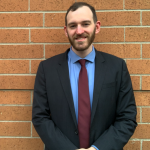Engaging donors from specific demographic groups
Stem cell and blood donor projects
Stem Cell: Virtual recruitment campaigns to engage specific demographic groups as donors
Dr Warren Fingrut
Allogeneic stem cell transplantation is a potentially curative therapy for patients with high risk or advanced hematologic malignancies; however, most patients (>75%) do not have a fully matched donor in their family and require an alternative donor such as a matched unrelated donor. Patients from diverse racial/ethnic groups face disparity in access to unrelated donors, with significantly decreased likelihood of finding a match compared to patients of Northwest European ancestry.
Dr Warren Fingrut founded the Stem Cell Club in 2011 to enhance recruitment of young and diverse unrelated donors in Canada. In his recent DoRN Week of Talks presentation, Warren discusses how the organisation uses virtual campaigns such as Black Donors Save Lives and Saving Lives with Pride to recruit specific demographics of donors.
To learn more about the Stem Cell Club, please click here.
To view Warren’s talk for free, please click the video below:
Blood: Co-designing with ethnic minority communities to facilitate increased donation awareness
Dr Luke Gahan
Lifeblood faces difficulty meeting the increasing demands for Jk(a-b-) blood type. The current data show that Polynesians have the highest frequency of this blood type, and the number of Polynesian Australians is growing fast. From 2006-2011 the Polynesian Australian population grew by 38%.
While the number of people in Australia with Polynesian ancestry continues to go up, Lifeblood has not seen the same rise in the number of Polynesian Australians in the blood donor panel. In his recent DoRN Week of Talks presentation, Luke discusses the use of co-design methodology to work with ethnic minority communities to develop strategies to encourage more blood donation.
To learn more about Lifeblood, please click here.
To view Luke’s talk for free, please click the video below:
Q & As
The DoRN Week of Talks provided a unique opportunity to engage in an easy and convenient Q & A with presenters. Below we have listed the questions that we received for Warren and Luke, along with their answers.

Q&A- Dr Warren Fingrut
Do you have any plans to extend your community of practice from recruiters to people on the stem cell registry (i.e., making a community for those on the stem cell registry)?
Our community of practice includes recruiters, registry staff, stem cell donors & recipients, patients currently searching for a match, and family members & caregivers. Most of our recruiters are also themselves swabbed and on the stem cell registry. A good way to expand the community further would be to invite people on the stem cell registry to join and participate, and we will explore this option.

Q&A- Dr Luke Gahan
Could the co-design approach and process be introduced and institutionalized more widely to the blood service donor collaboration; for example, could it be applied to finding ways to work with the blood donors on questions about participation in biobanking?
Yes – I very much believe that the co-design process/approach could and should be introduced as a normal practice when working with the wider donor panel and not just ethnic minority donors. I strongly believe we should be asking donors what they want/need and will respond to and involve them in the design of materials beyond recruitment/retention. It would be great to use co-design in designing donor health materials prior to donating but also those that are provided after an adverse event. It certainly could be used for participation in biobanking and I would definitely recommend it.
How did you mitigate/ explain the potential trust breach that could come from blood donated by Pacific Islanders, and intended for Pacific Islanders, being given to people outside of the community?
This is a good question and interestingly this came up recently when an elder in one of the Polynesian communities wanted to know which particular Polynesian community a patient requiring Jk(a-b-) was from. The elder was not concerned that the blood would go to someone outside (there was no belief/concern that the blood needed to stay in their community), they were just saying that motivation to donate would be higher if people knew it was from their community – and by community not just Polynesian, but from their particular Polynesian ethnic group.
I think the best policy is to always be honest. We were very clear with our participants that Jk(a-b-) is not just a Polynesian blood type and that in Australia patients can often have Filipino ancestry and that if someone is Jk(a-b-) there blood will not just go to Polynesian patients. Likewise, we were clear that most of the Pacific Donors are not going to be Jk(a-b-) and their blood will go to anyone from any community. This did not seem to be an issue. While ensuring we are honest and clear, they also said we should still focus on the fact that there are people in their community who need a rare blood type which is mostly found among their communities and that we needed their help to find this. So we never said it was only going to their community. One of the things we would like to do in the future is to have more information about blood donation written by the communities for their communities and this topic would be discussed in there.